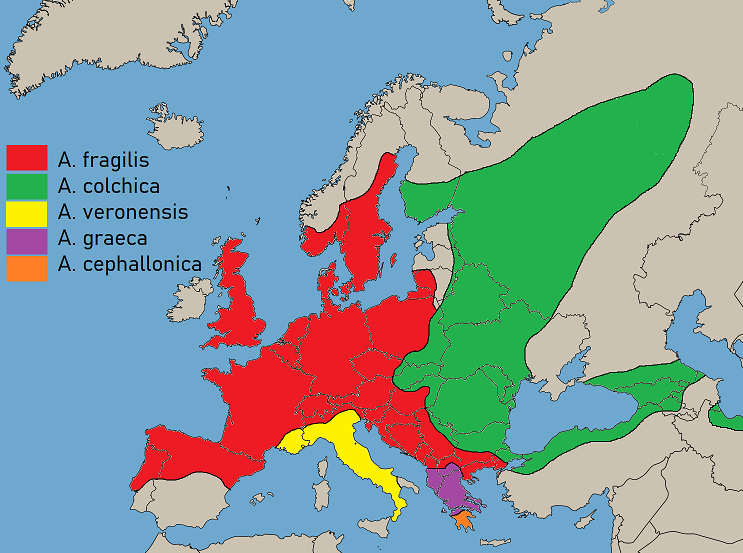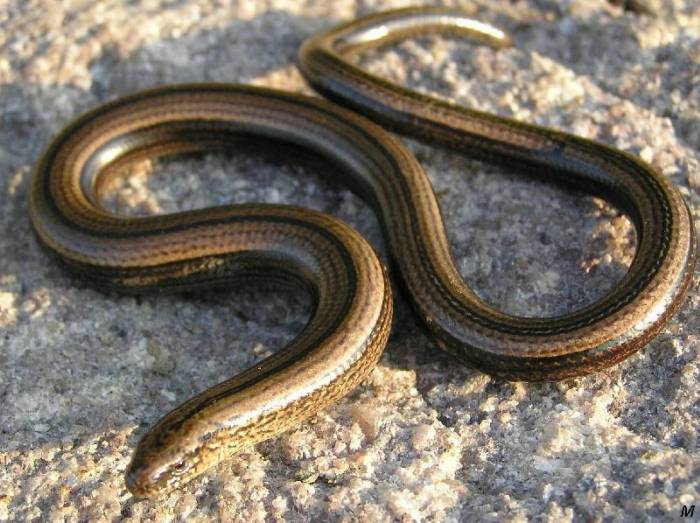|
Anguis
SlowwormsThe "slow-" in slowworm is distinct from the English adjective ''slow'' ("not fast"); the word comes from Old English ''slāwyrm'', where ''slā-'' means "slowworm" and ''wyrm'' means "serpent, reptile". () (also called blindworms and hazelworms) are a small genus (''Anguis'') of snake-like legless lizards in the family Anguidae. The genus has several living species, including the common slowworm, the eastern slowworm, the Greek slowworm, the Peloponnese slowworm, and the Italian slowworm (''Anguis veronensis''). There are also known fossil species. Description Slowworms are typically grey-brown, with the females having a coppery sheen and two lateral black stripes, and the males displaying electric blue spots, particularly in the breeding season. They give birth to live young, which are about long at birth and generally have golden stripes. Slowworms are slow-moving and can be easily caught, which has given rise to the folk etymology that the "slow" in slowworm is ... [...More Info...] [...Related Items...] OR: [Wikipedia] [Google] [Baidu] |
Anguis Fragilis
The slow worm (''Anguis fragilis'') is a reptile native to western Eurasia. It is also called a deaf adder, a slowworm, a blindworm, or regionally, a long-cripple and hazelworm. These legless lizards are also sometimes called common slowworms. The "blind" in blindworm refers to the lizard's small eyes, similar to a blindsnake (although the slowworm's eyes are functional). Slow worms are semifossorial (burrowing) lizards, spending much of their time hiding underneath objects. The skin of slow worms is smooth with scales that do not overlap one another. Like many other lizards, they autotomize, meaning that they have the ability to shed their tails to escape predators. While the tail regrows, it does not reach its original length. In the UK, they are common in gardens and allotments, and can be encouraged to enter and help remove pest insects by placing black plastic or providing places to shelter such as piles of logs, corrugated iron sheets or under tiles. On warm days, one or ... [...More Info...] [...Related Items...] OR: [Wikipedia] [Google] [Baidu] |
Anguis Graeca
''Anguis graeca'', the Greek slow worm, is a species of lizard in the family Anguidae found in Greece, Albania, and North Macedonia North Macedonia, ; sq, Maqedonia e Veriut, (Macedonia before February 2019), officially the Republic of North Macedonia,, is a country in Southeast Europe. It gained independence in 1991 as one of the successor states of Socialist Feder .... It engages in death feigning behavior when threatened. References Anguis Reptiles described in 1881 Lizards of Europe Taxa named by Jacques von Bedriaga Taxobox binomials not recognized by IUCN Legless lizards {{lizard-stub ... [...More Info...] [...Related Items...] OR: [Wikipedia] [Google] [Baidu] |
Anguis Colchica
''Anguis colchica'', the eastern slowworm, is a species of lizard in the family Anguidae Anguidae refers to a large and diverse family of lizards native to the Northern Hemisphere. Common characteristics of this group include a reduced supratemporal arch, striations on the medial faces of tooth crowns, osteoderms, and a lateral fold ... found in Europe and Asia. References Anguis Reptiles described in 1840 Lizards of Europe Lizards of Asia Taxa named by Alexander von Nordmann Taxobox binomials not recognized by IUCN {{lizard-stub ... [...More Info...] [...Related Items...] OR: [Wikipedia] [Google] [Baidu] |
Peloponnese Slowworm
The Peloponnese slowworm (''Anguis cephalonnica'') is a species of lizard in the family Anguidae endemic to Greece. Its natural habitats are temperate forests, temperate shrubland, Mediterranean-type shrubby vegetation, temperate grassland, arable land, pastureland, plantation A plantation is an agricultural estate, generally centered on a plantation house, meant for farming that specializes in cash crops, usually mainly planted with a single crop, with perhaps ancillary areas for vegetables for eating and so on. The ...s, and rural gardens. References Anguis Reptiles described in 1894 Lizards of Europe Endemic fauna of Greece Taxa named by Franz Werner Taxonomy articles created by Polbot Taxobox binomials not recognized by IUCN {{lizard-stub ... [...More Info...] [...Related Items...] OR: [Wikipedia] [Google] [Baidu] |
10th Edition Of Systema Naturae
The 10th edition of ''Systema Naturae'' is a book written by Swedish naturalist Carl Linnaeus and published in two volumes in 1758 and 1759, which marks the starting point of zoological nomenclature. In it, Linnaeus introduced binomial nomenclature for animals, something he had already done for plants in his 1753 publication of '' Species Plantarum''. Starting point Before 1758, most biological catalogues had used polynomial names for the taxa included, including earlier editions of ''Systema Naturae''. The first work to consistently apply binomial nomenclature across the animal kingdom was the 10th edition of ''Systema Naturae''. The International Commission on Zoological Nomenclature therefore chose 1 January 1758 as the "starting point" for zoological nomenclature, and asserted that the 10th edition of ''Systema Naturae'' was to be treated as if published on that date. Names published before that date are unavailable, even if they would otherwise satisfy the rules. The only ... [...More Info...] [...Related Items...] OR: [Wikipedia] [Google] [Baidu] |
Legless Lizard
Legless lizard may refer to any of several groups of lizards that have independently lost limbs or reduced them to the point of being of no use in locomotion.Pough ''et al.'' 1992. Herpetology: Third Edition. Pearson Prentice Hall:Pearson Education, Inc., 2002. It is the common name for the family Pygopodidae. These lizards are often distinguishable from snakes on the basis of one or more of the following characteristics: possessing eyelids, possessing external ear openings, lack of broad belly scales, notched rather than forked tongue, having two more-or-less-equal lungs, and/or having a very long tail (while snakes have a long body and short tail). Many families of lizards have independently evolved limblessness or greatly reduced limbs (which are presumably non-functional in locomotion), including the following examples: * Anguidae – 102 species, of which 17 are limbless and in the genera ''Ophisaurus'', ''Pseudopus'' and '' Anguis'' from Eurasia and North America. * Cordyli ... [...More Info...] [...Related Items...] OR: [Wikipedia] [Google] [Baidu] |
Anguidae
Anguidae refers to a large and diverse family of lizards native to the Northern Hemisphere. Common characteristics of this group include a reduced supratemporal arch, striations on the medial faces of tooth crowns, osteoderms, and a lateral fold in the skin of most taxa. The group includes the slowworms, glass lizards, and alligator lizards, among others. The family is divided into two subfamilies (Anguinae and Gerrhonotinae), and contains about 87 species in 8 genera. Morphology and reproduction Anguids have hard osteoderms beneath their scales giving them an armored appearance. Many of the species have reduced or absent limbs, giving them a snake-like appearance, while others are fully limbed. Body type varies among species, with sizes ranging from 10 cm to 1.5 m. The group includes oviparous and viviparous species, both of which can be observed in a single genus at times. Feeding and habitat These lizards are known carnivorous or insectivorous foragers, feeding p ... [...More Info...] [...Related Items...] OR: [Wikipedia] [Google] [Baidu] |
Slug
Slug, or land slug, is a common name for any apparently shell-less terrestrial gastropod mollusc. The word ''slug'' is also often used as part of the common name of any gastropod mollusc that has no shell, a very reduced shell, or only a small internal shell, particularly sea slugs and semislugs (this is in contrast to the common name ''snail'', which applies to gastropods that have a coiled shell large enough that they can fully retract their soft parts into it). Various taxonomic families of land slugs form part of several quite different evolutionary lineages, which also include snails. Thus, the various families of slugs are not closely related, despite a superficial similarity in the overall body form. The shell-less condition has arisen many times independently as an example of convergent evolution, and thus the category "slug" is polyphyletic. Taxonomy Of the six orders of Pulmonata, two – the Onchidiacea and Soleolifera – solely comprise slugs. A third family, ... [...More Info...] [...Related Items...] OR: [Wikipedia] [Google] [Baidu] |
Brille
The brille (also called the ocular scale, eye cap or spectacle) is the layer of transparent, immovable disc-shaped skin or scale covering the eyes of some animals for protection, especially in animals without eyelids. The brille has evolved from a fusion of the upper and lower eyelids. Brille means "spectacles" or "glasses" in German, Norwegian, and Danish, as well as "shine" in French and Spanish. In snakes, there are no eyelids and the brille is clear and cannot be distinguished, except when the animal is becoming ready for ecdysis. At that time, it becomes cloudy and is visible as a cover over the eye. When the snake moults, the brille is also shed, generally inside out, as part of its skin. The brilles protect their eyes from dust and dirt and give them a "glassy-eyed" blank appearance. Snakes, flap-footed lizards, night lizards, and some skinks have brilles. All geckos except those in the subfamily Eublepharinae (eyelid geckos) possess brilles. Some groups of bony fish ha ... [...More Info...] [...Related Items...] OR: [Wikipedia] [Google] [Baidu] |
Poland
Poland, officially the Republic of Poland, is a country in Central Europe. It is divided into 16 administrative provinces called voivodeships, covering an area of . Poland has a population of over 38 million and is the fifth-most populous member state of the European Union. Warsaw is the nation's capital and largest metropolis. Other major cities include Kraków, Wrocław, Łódź, Poznań, Gdańsk, and Szczecin. Poland has a temperate transitional climate and its territory traverses the Central European Plain, extending from Baltic Sea in the north to Sudeten and Carpathian Mountains in the south. The longest Polish river is the Vistula, and Poland's highest point is Mount Rysy, situated in the Tatra mountain range of the Carpathians. The country is bordered by Lithuania and Russia to the northeast, Belarus and Ukraine to the east, Slovakia and the Czech Republic to the south, and Germany to the west. It also shares maritime boundaries with Denmark and Sweden. ... [...More Info...] [...Related Items...] OR: [Wikipedia] [Google] [Baidu] |
United Kingdom
The United Kingdom of Great Britain and Northern Ireland, commonly known as the United Kingdom (UK) or Britain, is a country in Europe, off the north-western coast of the continental mainland. It comprises England, Scotland, Wales and Northern Ireland. The United Kingdom includes the island of Great Britain, the north-eastern part of the island of Ireland, and many smaller islands within the British Isles. Northern Ireland shares a land border with the Republic of Ireland; otherwise, the United Kingdom is surrounded by the Atlantic Ocean, the North Sea, the English Channel, the Celtic Sea and the Irish Sea. The total area of the United Kingdom is , with an estimated 2020 population of more than 67 million people. The United Kingdom has evolved from a series of annexations, unions and separations of constituent countries over several hundred years. The Treaty of Union between the Kingdom of England (which included Wales, annexed in 1542) and the Kingdom of Scotland in 170 ... [...More Info...] [...Related Items...] OR: [Wikipedia] [Google] [Baidu] |
Protected Species
An endangered species is a species that is very likely to become extinct in the near future, either worldwide or in a particular political jurisdiction. Endangered species may be at risk due to factors such as habitat loss, poaching and invasive species. The International Union for Conservation of Nature (IUCN) Red List lists the global conservation status of many species, and various other agencies assess the status of species within particular areas. Many nations have laws that protect conservation-reliant species which, for example, forbid hunting, restrict land development, or create protected areas. Some endangered species are the target of extensive conservation efforts such as captive breeding and habitat restoration. Human activity is a significant cause in causing some species to become endangered. Conservation status The conservation status of a species indicates the likelihood that it will become extinct. Multiple factors are considered when assessing the st ... [...More Info...] [...Related Items...] OR: [Wikipedia] [Google] [Baidu] |





_skannat.jpg)
